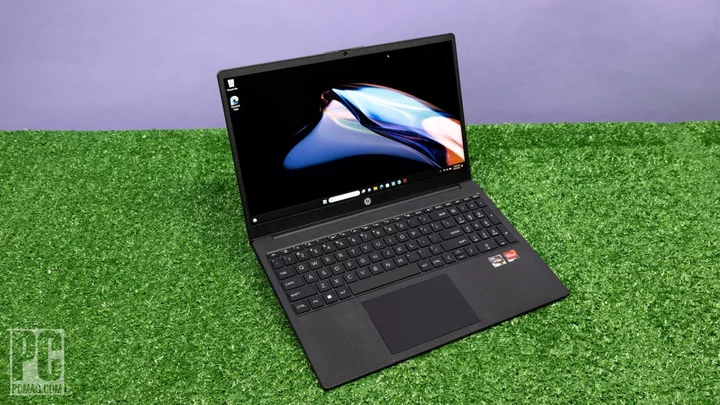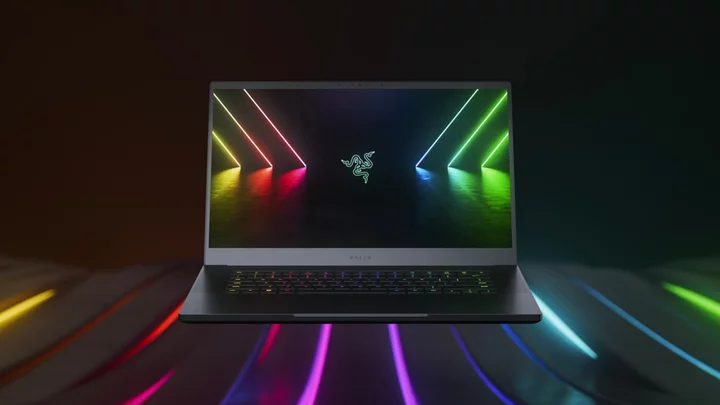Premium laptops make the headlines, but budget laptops make the world go around for many consumers. HP's least expensive 15.6-inch Windows notebook, the Laptop 15z, starts at just $279.99 ($609.99 as tested). It has the essentials for home and school and lasts for a long time unplugged, but that's about it. The system's build quality, screen, and keyboard are below par even for the economy class. The Lenovo IdeaPad 3i 15 is more appealing, and you can do even better if you spend a tad more for the Acer Aspire 5.
The Design: No-Frills Economics
The Laptop 15z has only enough performance to get you online in its $279.99 starting configuration, which combines a dual-core AMD Athlon processor, 8GB of memory, and a 128GB solid-state drive. It's tragically saddled with an 11-inch-Chromebook-class 1,366-by-768-pixel screen, which is easily avoided by spending $20 for a far sharper and more desirable full HD (1,920-by-1,080-pixel) panel. (HP doesn’t seem to stock many preconfigured Laptop 15z models but will readily build you one to order.)
(Credit: Joseph Maldonado)Doubling the storage (to 256GB) carries the same $20 upcharge, while stepping up to a more competent quad-core Ryzen 3 processor adds $60. All told, a reasonable loudout for under $400 is well within the range of possibility. Our $609.99 test unit was loaded with a six-core AMD Ryzen 5 7530U, 12GB of RAM, a 512GB SSD, and a low-blue-light 1080p display, making it more of a midrange contender.
If you prefer Intel to AMD silicon, HP offers the Laptop 15t (that's t, not z) starting at $379, which apart from the CPU seems identical to the Laptop 15z. CPU choice isn't a big concern for a budget laptop—the priority is just getting a usable machine—but at least HP gives you options. You can also find 14- and 17.3-inch flavors of this laptop that differ only in screen size and keyboard layout.
At 0.73 by 14.2 by 9.3 inches (HWD) and 3.5 pounds, the Laptop 15z is of average size and weight for an economy 15.6-inch rig. Our review unit looks especially spartan in black plastic; one of HP's optional colors (Natural Silver, Diamond White, Moonlight Blue, and Pale Rose Gold) can improve its visual appeal.
(Credit: Joseph Maldonado)The 15z's all-plastic construction is the norm for rock-bottom-priced laptops; I normally wouldn't carry on about it except this HP's lack of strength is alarming. The chassis is so flexible that even pressing on the touchpad causes the whole laptop to bend. Treating the notebook roughly or even picking it up one-handed isn't advised.
The keyboard echoes the hollow plastic feel, with presses that feel and sound uninspiring. I scored below my standard in the Monkeytype online typing test at only 94 words per minute with 97% accuracy. There's no keyboard backlighting available, which is understandable at the Laptop 15z's base price, but not so for my over-$600 test unit. The buttonless touchpad is reasonably sized and tracks well, though I avoided pressing to click because of the chassis flex.
(Credit: Joseph Maldonado)Ports include one USB Type-A, one USB Type-C, an HDMI monitor port, and an audio jack on the left side and another USB-A and the AC adapter connector at right. All the USB ports are version 3.2 offering 5Gbps of bandwidth, which is plenty for this laptop's intended usage. The HDMI port is unfortunately version 1.4b, which only allows 4K output at a slide-show-like 30Hz refresh rate instead of the 60Hz you'd get from HDMI 2.0b. Still, in this price range, that's unlikely to be a deal-breaker.
(Credit: Joseph Maldonado)The Screen: At Least It’s 1080p
Before I say anything more about my review unit, I'm morally obligated to reiterate that the HP's base 1,366-by-768-pixel screen should be avoided unless you want to feel like you're in the early 2000s. Stepping up to the 1080p panel is easily worth the $20, and Windows' built-in scaling can increase the font size in nearly all apps if you're concerned about text readability.
Granted, the $20 upcharge gets you a glossy 250-nit panel HP refers to as BrightView; our Laptop 15z had the $90 anti-glare version, which has a higher rated brightness of 300 nits as well as being advertised as low in blue light emissions. I found it plenty bright for indoor use and appreciate that the picture didn't distort when viewed from off center. Colors, however, appeared washed out and not true to life, with reds looking more like orange. If screen reflections aren't a problem for you, I'd recommend sticking with the $20 upgrade; $90 is a lot in this starting price range.
(Credit: Joseph Maldonado)The standard 720p webcam above the display has blocky image quality but gets the job done, and even offers a sliding privacy shutter. With neither infrared face recognition nor a fingerprint reader, you'll be stuck typing passwords instead of using Windows Hello. Getting biometric features requires stepping up to HP's Pavilion, Envy, or Spectre lines.
Audio from the Laptop 15z's twin speakers is passable. Any basic Bluetooth speaker will sound better, but the onboard sound is reasonably clear and loud enough for casual listening. An included Audio Center app provides presets and an equalizer. The default music preset sounded the most balanced to my ears in everything from Queen’s "We Will Rock You" to Top Gun: Maverick.
Like many consumer PCs, the Laptop 15z comes with a fair amount of unwanted software and trial apps installed, including WildTangent games and a McAfee antivirus trial. It took only a few minutes to uninstall the bloatware, after which the laptop was ready to work. The standard warranty is one year.
Testing the HP Laptop 15z: Everyday AMD Power
HP seems to offer two customizable Laptop 15z models, both listed as Laptop 15z-fc000. The $279.99 version has fixed (not upgradable) memory, and its peak CPU offering is the quad-core AMD Ryzen 5 7520U. The model reviewed here starts at $379.99 with a six-core Ryzen 5 7530U and has user-upgradable memory (two SO-DIMM slots under its bottom panel). All configurations come with Bluetooth and Wi-Fi 6, not the newer Wi-Fi 6E, but that's not a deal-breaker for a budget laptop.
While our test unit rang up at $609.99, recommending a configuration of the 15z above $400, or at most $500, is difficult since this laptop's quality is quickly outclassed by systems with higher starting prices. As I said, if you start with the lower-priced model and configure it upward, you should be able to get a Ryzen 3 CPU, 8GB of RAM, a 256GB solid-state drive, and a 1080p display for under $400. That seems the ideal balance point for this model.
The loaded Laptop 15z seen here should fare well, performance-wise, against the crop of budget machines I chose for our comparison charts. The Acer Aspire 3, the Dell Inspiron 15, and the abovementioned Lenovo IdeaPad 3i 15 are all plastic and have minimalist features like the HP. I gave the last spot to the slightly more upscale Acer Aspire 5. The processors are a mix of Intel Core i5 and AMD Ryzen 3 and Ryzen 5 parts, all relying on integrated graphics, with the Laptop 15z's Ryzen 5 making it the overdog.
Productivity and Content Creation Tests
Our first test. UL's PCMark 10, simulates a variety of real-world productivity and office workflows to measure overall system performance and also includes a storage subtest for the primary drive. The Laptop 15z zoomed past the 4,000 points we consider the sign of suitable productivity for everyday tasks, with the Aspire 5 and Inspiron 15 trailing. The HP also aced the storage test.
Three other benchmarks focus on the CPU, using all available cores and threads, to rate a PC's suitability for processor-intensive workloads. Maxon's Cinebench R23 uses that company's Cinema 4D engine to render a complex scene, while Primate Labs' Geekbench 5.4 Pro simulates popular apps ranging from PDF rendering and speech recognition to machine learning. Finally, we use the open-source video transcoder HandBrake 1.4 to convert a 12-minute video clip from 4K to 1080p resolution (lower times are better).
Our final productivity test is workstation maker Puget Systems' PugetBench for Photoshop, which uses the Creative Cloud version 22 of Adobe's famous image editor to rate a PC's performance for content creation and multimedia applications. It's an automated extension that executes a variety of general and GPU-accelerated Photoshop tasks ranging from opening, rotating, resizing, and saving an image to applying masks, gradient fills, and filters.
The Laptop 15z landed just below the Core i5-based Aspire 5 in our CPU tests, but it certainly has adequate horsepower for mainstream apps. It even completed our Photoshop benchmark, which not all budget laptops can do, though image editing on its screen isn't a good idea if you value color accuracy. (More about that in a moment.)
Graphics and Gaming Tests
We test Windows PCs' graphics chops with four gaming simulations. Two are DirectX 12 benchmarks from UL's 3DMark—the more modest Night Raid (suitable for systems with integrated graphics), and the tougher Time Spy (demanding enough for gaming rigs with discrete GPUs). We also run two tests, rendered off-screen at different resolutions, from the cross-platform OpenGL benchmark GFXBench 5.
The HP's AMD Radeon integrated graphics aren't in the same ZIP code as the discrete GPU of a gaming laptop, but for the most part produced better numbers than the Intel integrated graphics of the rival Aspire 5. The Laptop 15z can handle casual or browser-based gaming or vintage titles, but your best bet for gameplay on budget laptops like these is a streaming service such as GeForce Now.
Battery and Display Tests
We test laptops' battery life by playing a locally stored 720p video file (the open-source Blender movie Tears of Steel) with screen brightness at 50% and audio volume at 100% until the system quits. Wi-Fi and keyboard backlighting are turned off during the test.
We also use a Datacolor SpyderX Elite monitor calibration sensor and its software to measure a laptop screen's color saturation—what percentage of the sRGB, Adobe RGB, and DCI-P3 color gamuts or palettes the display can show—and its brightness in nits (candelas per square meter) at the screen's 50% and peak settings.
Today's budget laptops no longer suffer from brief battery life. The HP's 14-plus hours is a great time even compared to costlier machines; only the Aspire 3 outlasted it. On the other hand, our SpyderX Elite measurements show that screen quality is still a real Achilles' heel for economy models, with poor coverage of even the undemanding sRGB spectrum, let alone the image-editing Adobe RGB and video-oriented DCI-P3, across the board. At least the Laptop 15z's display proved as bright as HP advertises, though the Lenovo was brighter.
Verdict: Not Bad, But You Can Get a Better Budget Laptop
Economy laptops fill an important niche for users who can't or don't want to spend a lot, and the HP Laptop 15z goes a long way toward serving those needs. A configuration under $400 can deliver all the hardware you need for basic home use or homework, but our loaded test system is configured out of its league; decent components paired with subpar build quality and a poor keyboard hold it back from a higher rating. The Lenovo IdeaPad 3 15 is more well-rounded, and if you can afford a little more, Acer's Aspire 5 is the machine to get.









